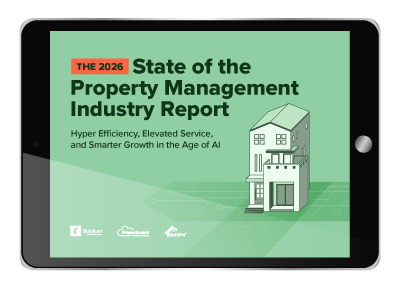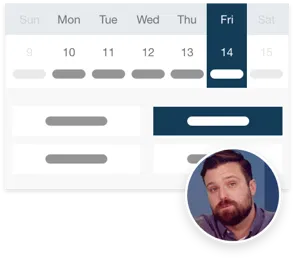In any homeowners’ association (HOA), even simple maintenance tasks can help create a community that feels safe, cared for, and well-managed.
When tasks are completed on time, you avoid costly repairs and keep residents happy by maintaining the spaces they rely on. But if projects are delayed or poorly communicated, frustration builds (and so do the complaints). That’s why buttoned-up HOA maintenance scheduling is important.
In this post, we’ll explore how HOA managers can optimize HOA maintenance schedules to meet every deadline and keep residents satisfied. We’ll cover best practices, strategic planning, communication techniques, and methods to set up better maintenance processes.
The Basics of HOA Maintenance Scheduling
An HOA maintenance schedule is a plan that organizes when and how community maintenance tasks get completed. It covers routine work like landscaping and cleaning, plus preventive tasks that avoid costly repairs.
- Prevent Problems: Timely and regular maintenance stops small issues from turning into major repairs or safety concerns.
- Boost Efficiency: Proper scheduling makes the best use of time and resources, to get tasks completed on time without overburdening staff or contractors.
- Increase Resident Satisfaction: When residents notice maintenance tasks are handled proactively, they feel more secure and are more likely to be satisfied with the HOA’s management, an important factor in states like Nevada, Florida, and Arizona, which have the highest proportions of homeowners paying HOA fees.
Even though most maintenance work shares these benefits, the projects themselves can vary greatly depending on your property and the nature of the job. because of this, it helps to bucket HOA maintenance tasks into three main categories:
- Routine Maintenance: Tasks that are scheduled regularly to maintain day-to-day operations, such as cleaning common areas or mowing lawns.
- Preventive Maintenance: Tasks that address potential issues before they become significant problems, such as inspecting HVAC systems or checking plumbing for wear.
- Emergency Maintenance: Unplanned tasks that arise unexpectedly, such as fixing a broken fence or repairing a burst pipe. Emergency tasks require immediate attention to prevent damage or disruption.
Each type of maintenance requires a different scheduling approach. Routine tasks often follow a predictable cycle, while preventive and emergency tasks need more flexibility in planning.
Types of HOA Maintenance Plans
Effective HOA maintenance uses four different plan types that work together to keep your community running smoothly.
Preventive Maintenance Plan
This is your forward-looking plan. It includes regular inspections and servicing of equipment to catch small problems before they become large ones, helping to control costs.
Seasonal Maintenance Plan
This plan groups tasks that are specific to a particular time of year. It helps you prepare for changing weather and conditions. Examples include winterizing irrigation systems in the fall, cleaning gutters in the spring, and servicing the community pool before summer.
Deferred Maintenance Plan
Sometimes, non-urgent repairs get postponed due to budget or timing constraints. A deferred maintenance plan tracks these items. It makes sure they are not forgotten and can be prioritized in future budgets. This could include repainting common area hallways or replacing older carpeting.
Condition-Based Maintenance Plan
This approach triggers maintenance only when certain conditions are met. It often relies on inspections or performance monitoring. For example, a common area might be scheduled for deep cleaning only after a large community event, or a playground surface might be repaired only when wear and tear reaches a specific point.
Essential Components of Your HOA Maintenance Schedule
Each maintenance task in your schedule needs specific information to stay organized:
| Component | Purpose |
|---|---|
| Task Description | Clear explanation of work needed |
| Location | Specific area or asset requiring maintenance |
| Frequency | How often to perform (daily, weekly, monthly, etc.) |
| Responsible Party | Assigned staff member or vendor |
| Estimated Cost | Budgeted amount for financial planning |
| Last Completed | When task was last performed |
| Next Due Date | Upcoming deadline |
How to Build an HOA Maintenance Schedule
Creating a comprehensive HOA maintenance schedule involves a strategic and thoughtful approach. Follow these key steps to create a plan that is both effective and adaptable.
1. Assess the Property’s Needs
Walk through your community to assess maintenance needs:
- Landscaping: Mowing, pruning, seasonal planting
- Common Areas: Lobbies, hallways, pools, fitness centers
- Building Utilities: HVAC, plumbing, electrical components
2. Prioritize Tasks
Once you’ve identified the necessary tasks, prioritize them based on urgency, budget, and seasonality. For instance:
- Urgent Tasks: Safety issues, such as fixing broken gates or faulty lights, should be addressed first.
- Seasonal Tasks: Certain tasks, such as snow removal or gutter cleaning, may be necessary only during specific seasons.
- Routine Tasks: Tasks such as landscaping or regular cleaning should be scheduled consistently.
Considering urgency and seasonality will help you stay organized and keep the schedule manageable.
3. Allocate Time and Resources
Next, allocate the necessary resources for each task. This includes assigning staff or contractors, determining budgets, and estimating how long each task will take. For example:
- Assigning a landscaping contractor to handle weekly lawn mowing.
- Scheduling maintenance workers for monthly inspections of plumbing or electrical systems.
Set realistic timelines to make sure tasks are completed without rushing, resulting in better quality work.
4. Build in Flexibility
No schedule will follow a perfect path. Unplanned issues, such as weather delays or unexpected repairs, will arise. To manage these disruptions, make sure to build flexibility into your schedule. Leave room for unplanned work and adjust priorities as needed.
5. Loop in Residents and the HOA Board
Requesting feedback from residents and the HOA board is a valuable step in refining the HOA maintenance schedule. Regularly ask for input on areas of concern or tasks that might need more attention. For example, if multiple residents complain about cleanliness in common areas, this feedback should guide the scheduling of cleaning tasks.
Sample HOA Maintenance Checklist by Category
To help you get started, here are some examples of common maintenance tasks, organized by area and suggested frequency. Your community’s needs may vary.
Building Exteriors
- Inspect roofing for damage (Annually)
- Clean gutters and downspouts (Semi-Annually)
- Check exterior paint for chipping or fading (Annually)
- Inspect windows and doors for proper sealing (Annually)
- Power wash siding and walkways (As needed)
Interior Common Areas
- Test smoke detectors and fire alarms (Monthly)
- Inspect and clean HVAC filters (Quarterly)
- Check emergency lighting (Monthly)
- Clean carpets in hallways and lobbies (Semi-Annually)
- Inspect elevators for proper function (Per local regulations)
Grounds and Landscaping
- Mow and edge lawns (Weekly, during growing season)
- Prune trees and shrubs (Seasonally)
- Inspect irrigation systems (Monthly)
- Check playground equipment for safety (Quarterly)
- Manage snow and ice removal (As needed)
Communicating with Residents: How to Boost Satisfaction
Clear communication is a major factor when it comes to HOA maintenance scheduling. When residents know about upcoming work and potential disruptions in advance, they are more likely to be patient and understanding.
Here are some of the most effective ways to keep residents informed:
- Email Newsletters: Regular email updates help residents stay informed about scheduled maintenance and any expected disruptions. Send these updates in advance, explaining when work will happen, why it’s necessary, and how long it will take.
- Community Bulletin Boards: Post maintenance schedules on bulletin boards throughout the community. This gives residents who may not check email access to important updates.
- Digital Platforms: Many HOAs have community websites or apps. These platforms allow residents to view updates, ask questions, and stay informed about the maintenance schedule.
- Monthly or Quarterly Updates: Offering residents regular updates through newsletters or emails keeps them aware of any ongoing or future projects.
Even with the best communication practices, complaints happen. When issues do come up, respond quickly and clearly. For example, if a project causes noise, let residents know the timeframe so they can plan ahead.
Whenever possible, involve board members and other residents in decision-making. For instance, ask for input on landscaping choices or preferred times for maintenance. This builds trust and a sense of ownership.
Balancing Cost and Quality of HOA Maintenance
A good schedule helps you stay on budget but, at the same time, it should compromise the quality of maintenance work. Here are a few tips to achieve this balance:
1. Find Reliable Contractors
Spend time researching. Contractors with experience and strong references will provide higher-quality work and minimize the need for frequent repairs. Although opting for the cheapest option might seem appealing, investing in quality services will save money over time.
2. Negotiate Where You Can
Negotiate with contractors to secure the best possible rates. Many service providers offer discounts for bulk work or long-term contracts. You can save money without sacrificing quality if you’re able to negotiate fair terms.
3. Prioritize Preventive HOA Maintenance
Focus on preventive maintenance to avoid costly emergency repairs down the road. Regular inspections help identify issues before they become expensive problems, which ultimately saves money.
4. Be Strategic with Resources
Consider cost-effective strategies where appropriate. For instance, HOA residents can volunteer for minor tasks, or staff can handle small maintenance jobs in-house. Be careful that your approach doesn’t compromise safety or work quality.
Use Technology to Streamline HOA Maintenance Schedules
The right software tools can help automate tasks, improve communication, and keep everyone on track. Here are a few tools that can help HOA managers set up better HOA maintenance schedules:
Property Meld
Property Meld is a property maintenance management platform that helps property managers track and manage maintenance requests. The platform automates maintenance workflows, helping you stay organized and on top of tasks. Residents can submit requests directly, and you can track their progress in real-time. This level of transparency makes it easier to keep everyone informed and ensures that issues are addressed promptly.
LeadSimple
While LeadSimple is primarily a lead management tool, it offers features that can help HOA managers with HOA maintenance scheduling. The platform allows you to track work orders, manage tasks, and stay on top of communication with contractors and service providers. LeadSimple’s task management capabilities help get work orders completed on time and enables automated, timely updates to residents and vendors about work orders, with frequent two-way syncing and tracked communications.
Buildium
Perhaps the best type of software to help with not just your maintenance tasks, but also your entire HOA management workload is comprehensive property management software. Buildium is a solid example of software that combines maintenance, accounting, communication, and reporting tools in a single platform.
The main advantage of this is it lets you track and automate workflows easily. For example, for any given maintenance job, residents can submit tickets, receive updates, and communicate with you through a central portal.
As an HOA manager, you can also organize various related tasks under a single project and get a high-level overview of how each of your maintenance projects is progressing.
Invoices and payments can be automatically recorded in your digital ledger, so you can keep accurate, easy-to-access records and create reports whenever you need to—whether you’re sharing them with boards and using them for your own business.
Buildium also includes an open API, letting you customize workflows to reflect your specific maintenance schedules and integrate with trusted tools from the Buildium Marketplace—including Property Meld and LeadSimple.
Creating Your Own HOA Maintenance Schedules: The First Steps You Should Take
An effective HOA maintenance schedule protects property values and keeps residents satisfied. Regular review and adjustment keeps your plan responsive to changing needs.
Next steps to improve your maintenance scheduling:
- Assess your current process: Identify gaps in your maintenance tracking
- Choose the right tools: Consider software like Property Meld, LeadSimple, or Buildium
- Start small: Focus on one maintenance area before expanding
Want to see it in action? You can give Buildium a try by scheduling a demo or testing out their software for yourself with a 14-day free trial.
With the right tools and strategies, you can stay ahead of maintenance needs and build a stronger, more satisfied community.
Frequently Asked Questions About HOA Maintenance Scheduling
What is an example of maintenance scheduling?
A simple example is scheduling weekly lawn mowing every Friday from April to October. Another example is scheduling a licensed technician to inspect and service all community HVAC units every September before the heating season begins. These tasks are set at regular, predictable intervals.
What is the 10 percent rule of preventive maintenance?
The 10 percent rule is a guideline suggesting that a preventive maintenance task should be completed within a window of 10 percent of its scheduled frequency. For example, a monthly (30-day) task should be completed within three days of its due date. This rule helps keep maintenance on track without being overly rigid.
Do HOAs take care of all maintenance responsibilities?
No, an HOA is typically responsible for maintaining common areas—such as lobbies, pools, landscaping, and building exteriors—which are funded by homeowner fees. In 2024, the monthly median condo or HOA fee was $135. Individual homeowners are usually responsible for maintenance inside their own units. The specific responsibilities are defined in the HOA’s governing documents, so it’s always best to check those for details.
Read more on Associations

